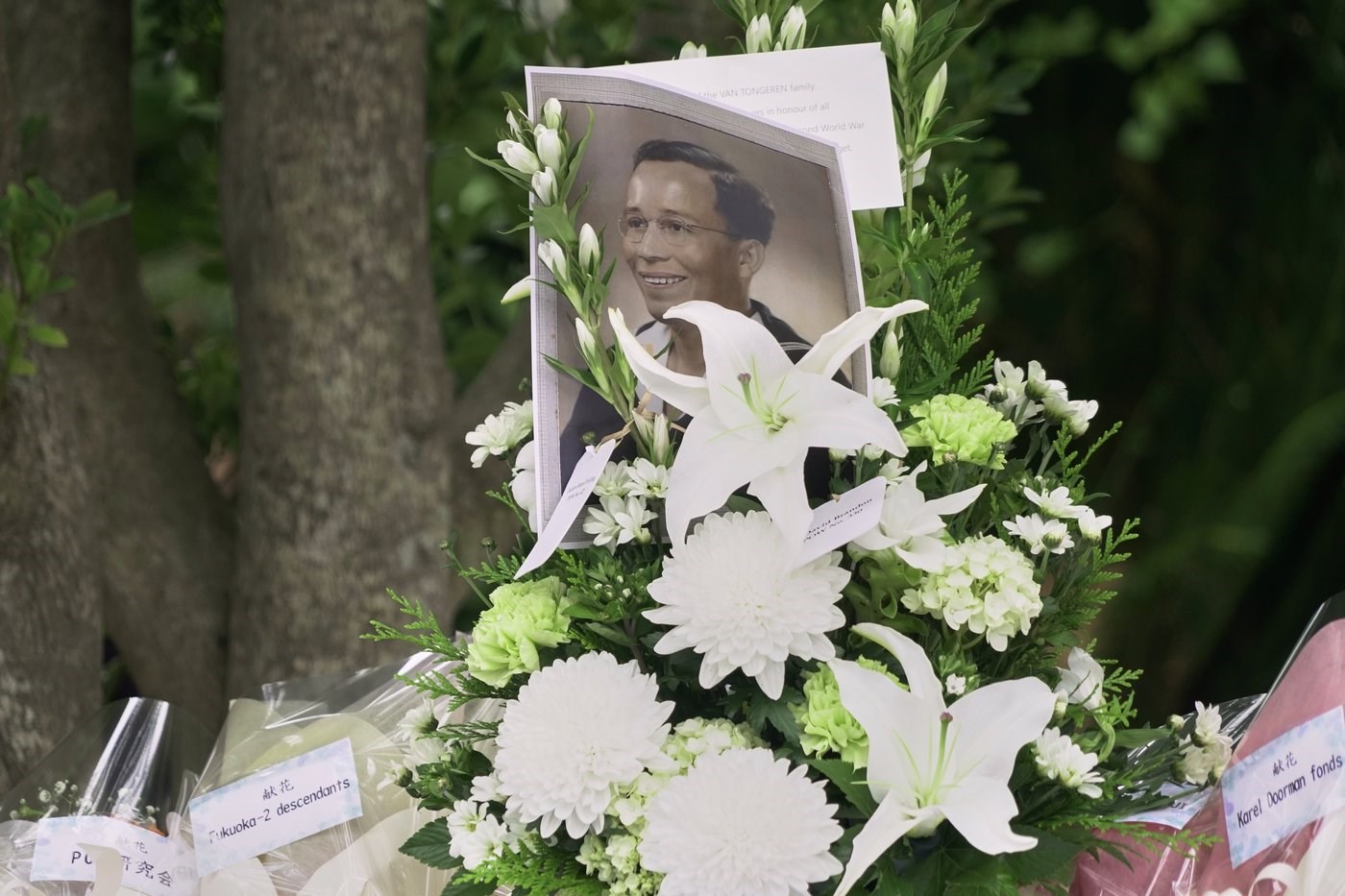
The portrait of a Dutch soldier who was held in wartime prison camps in Nagasaki, is placed by flowers during a ceremony for the victims of the Fukuoka POW Camp No. 2 in Koyagi, Nagasaki city, western Japan, Saturday, Sept. 13, 2025. (AP Photo/Mayuko Ono)
September 13, 2025 - 2:51 AM
KOYAGI, Japan (AP) — Dozens of relatives of former Dutch prisoners of war who suffered abuse and starvation during their captivity in one of Japan's largest World War II prison camps visited on Saturday the site where their loved ones were held in Nagasaki to pay tribute to their memory.
The commemoration comes as Japan this year marks the 80th anniversary of the atomic bombing of the southwestern city of Nagasaki — a blast that many of the Dutch POWs saw from their camp.
Their names are engraved in a stone monument at the Fukuoka POW Camp No. 2 — the site of the larger of the two war prisons in Nagasaki during the war — that was erected in 2015 with contribution from Japanese survivors of the Nagasaki bombing and their descendants as a symbol of reconciliation and peace.
A plea for peace
Andre Schram, representing the Dutch bereaved families, said at the ceremony that the monument "carries a message that goes beyond remembrance. It’s a plea for peace.”
“It also stands as a symbol of reconciliation between those whose ancestors were once enemies," added Schram.
His father, Johan Willem Schram, was a Dutch Navy sailor who survived the forced labor and hardship at the No. 2 camp in the last three years of the war and the atomic bombing on Aug. 9, 1945 — just a week before Japan's surrender.
Andre Schram published “Johan's Story,” an account about the Netherland's colonial rule of the Dutch East Indies, the war with Japan and the aftermath of WWII, based on his own research. While he was still alive, his father was reluctant to talk about his ordeal, overwhelmed by the trauma.
During the war, Japan held about 150,000 members of the Allied forces as prisoners in dozens of camps across Asia, including more than 30,000 in Japanese war prisons, according to the POW Research Network Japan.
In Japan, they were used as forced laborers at mines and factories to make up for labor shortage as Japanese men were drafted and deployed to battlefields across Asia.
Painful memories
The elder Schram was one of about 500 POWs at the No. 2 Camp in Nagasaki.
Most prisoners there were Dutch but there were also others, from the United States, Britain and Australia. None were directly killed as a result of the atomic blast but by the time the bomb was dropped on Nagasaki, more than 70 had died of malnutrition, overwork and illnesses.
After the U.S. dropped the plutonium bomb on Nagasaki at 11:02 a.m. on Aug. 9, 1945, more than 70,000 people died by the end of the year as victims of the bombing.
The attack came only three days after the U.S. dropped a uranium bomb on Hiroshima, destroying the city and killing 140,000 others. Japan announced its surrender on Aug. 15, ending World War II and the country’s nearly half-century of aggression in Asia.
Saturday's ceremony also underscored how the connection between the families of the "Dutch POWs who returned home with painful memories, and the descendants of atomic bombing survivors in Nagasaki is very symbolic,” said Kazuhiro Ihara, whose father was a survivor of the bombing and had also worked for reconciliation with the POWs.
“We have been organizing this event with the hope that it will be a step towards achieving a peaceful world," he said, adding that the Dutch and Japanese "hope to further deepen our exchanges from now on.”
On Friday, Emperor Naruhito visited Nagasaki with his wife Empress Masako and their daughter Princess Aiko to pay tribute to the victims of the atomic bombing and meet with some of the survivors, stressing the importance of telling the tragedy of war and learning from history.
A huge orange fireball
When the bomb was dropped on Nagasaki, prisoners at the No. 2 Camp, were about 10 kilometers (6.2 miles) from the so-called hypocenter — the precise focus of the bomb.
They saw a huge orange fireball, purple smoke and the mushroom cloud rising from the direction of the city of Nagasaki. Windows at the camp were shattered, doors fell off and the ceiling of the camp's clinic collapsed, injuring about 10 prisoners, historians say.
At the other camp, No. 14, which was closer to the blast, the brick buildings at the camp were destroyed, killing eight and injuring dozens.
In the days that followed, prisoners from the No. 2 camp provided rice and other assistance to their fellow prisoners from camp No. 14.
Schram's father and the other POWs at the No. 2 camp were officially notified of Japan's surrender on Aug. 18, and the U.S. B-29 delivered its first food drop for the Allied POWS on Aug. 26.
On Sept. 4, two days after the formal signing of the war's end, the POWs who survived left the camp to return their homeland.
___ The Associated Press receives support for nuclear security coverage from the Carnegie Corporation of New York and Outrider Foundation. The AP is solely responsible for all content. ___ Additional AP coverage of the nuclear landscape: https://apnews.com/projects/the-new-nuclear-landscape/
News from © The Associated Press, 2025